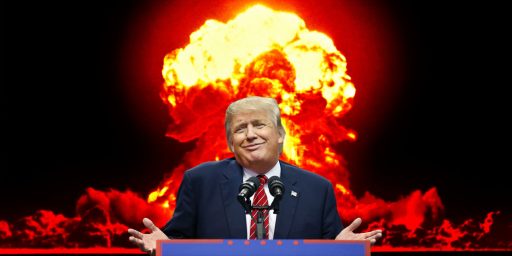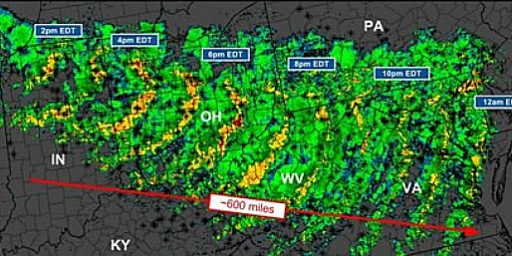The United States Is The Tornado Capital Of The World
Alexis Madrigal explains why:
The simple answer is that warm, moist air from the Gulf of Mexico gets sandwiched between warm, dry continental air and cold, dry air from drifting down from the Rockies. The combination creates the perfect conditions for thunderstorms to form. A more detailed explanation of the regional air movements is available here.
As these air masses collide, they can generate a type of particularly dangerous thunderstorm called a “supercell.” They are characterized by their very strong, rotating updrafts accompanied by strong downdrafts. Tornadoes tend to occur at the interface between these two air movements.
While meteorologists are not quite sure why some supercells spawn tornadoes while others do not, it’s clear that having strong thunderstorms makes supercells more likely and having more supercells makes tornadoes more likely. Hence, the areas with the most strong thunderstorms tend to have the most tornadoes.
75 percent of all tornadoes on Earth occur in North America. Per square mile, Oklahoma has the fifth-most tornadoes of any state, and the fourth-most tornadoes on an absolute basis after Texas, Kansas, and Florida.
Indeed, while one hears of hurricane-like storms arising in other parts of the world (in the Pacific they are generally called Cyclones or Typhoons), one doesn’t generally here of tornadoes striking with ferocity in any other parts of the world.






Tornadoes are also an important part of homeland defense. No standing army has been able to hold onto U.S. territory because of tornado strikes.
I was just wondering about this. You rarely hear about tornadoes/cyclones hitting other countries. I grew up in Australia, and there are periodic cyclones that hit the northern territory and queensland, but it’s nothing compared to the frequency of tornadoes in the U.S.
Once again I’m left to wonder if you and I speak the same language, Doug. In my version of English, typhoons are equivalent to hurricanes, not tornadoes. Both of those meteorological phenomena are considered cyclones.
I’m told I should follow a more descriptive approach to language than my accustomed prescriptive preference, so I’ll just shut up (finally) and let you use whatever words you want to make your point. Besides, it’s not like I’d be able to scrape them off the page or blank them out with highlighter or anything like that.
It is kinda funny that I have spent most of my 54 yrs living on the edge of Tornado Alley and spent more than a little time traversing it’s heart and yet have only seen one (which was to the east and therefor moving away from me).
@Boyd:
I thought it was clear that I was referring to hurricanes in that sentence, not tornadoes
@Doug Mataconis: My apologies, Doug, I read it as saying that “tornadoes are hurricane-like storms, which are called…” It didn’t occur to me that you’d refer to alternate terms for a hurricane in a post about tornadoes.
Years ago I read a seventeenth-century document from the New Hampshire Historical Society that was a first-person description of a “whyrlwinde” touching down and ravaging the countryside. I remember thinking how terrified the English settlers must have been by what truly must have seemed to them a manifestation of the wrath of God.